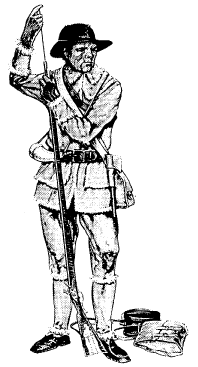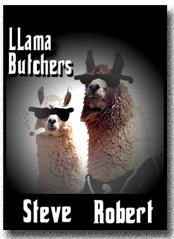May 01, 2007
Gratuitous Historickal Posting - Firearms Division

(Image lifted from AmericanRevolution.org)
Reader AKL left a couple of interesting questions in response to a recent post on the French & Indian War that I thought worth reposting, given that I myself do not know the answers:
Perhaps a frontier era historian could address a question that arose in our familly last week.Last weekend we took the kids and cousins to a Pioneer Days event supposedly more or less 1760's era. There were several very knowledgeable and accurate reenactors present fully outfitted as, I believe, Roger's Raiders. (Although not dressed, the cynic in me thinks, as a Raider would have looked AFTER a campaign.) Naturally the boys were fascinated by the weaponry, particularly the muzzle-loaders, and thus were fascinated by the re-enactors. The reenactors spent a good deal of time standing and resting their heads, hands, or other body parts on the mouth of the barrel. This occured to such an extent that finally a gun-toting grandmother asked that they be a little more observant of gun-safety wisdom if kids could see them. Their response was extensive.
One- they did not need to treat the gun as loaded because they knew it was not.
Two- a muzzle loader wasn't going to hurt them (one wonders then why Rogers Raider's carried them).
Three- resting on the barrel was historically accurate.
Is statement three accurate? On one hand are the various famous Western paintings of explorers/adventurers/pioneers standing and leaning on their guns- which admittedly are the right length to lean on. Without the paintings before us, none of us could remember if the subjects were leaning against the barrel or the mouth.
On the other hand it was postulated that the pioneers/explorers/adventurers thoroughly understood guns and would not do a damfool thing like lean on the mouth of the gun. It was suggested that even if paintings suggested the subject leaned on the gun mouth, the painter was a city slicker unfamiliar with guns.
Thought?
As I say, I don't know the answer but I certainly have seen the same kinds of paintings and illustrations.
My general take would be a) that guns were ubiquitous on the frontiers, boys, for example, being expected to shoot squirrels and rabbits for the family supper from a very, very young age. Given this, I would not be the slightest bit surprised at the average colonial rifleman being comfortable enough with his weapon to know when he could or couldn't lean against the muzzle with relative impunity.
Related to this somewhat, I would also say that b) early America, particularly on the borders of the wilderness, was not exactly what one would call a "risk-averse" society. I'm sure accidents happened, but life was cheap back then. If our gun-totin' grandma were to appear and start fussing at a group of Rogers' Rangers about gun safety, I'm sure she would have been hooted into Lake Champlain.
UPDATE: In the "Why I Really Ought Not To Be Blogging" Category, talk of Rogers' Rangers prompted me to nip over to the Devil's Website and pick up this:

The Annotated and Illustrated Journals of Major Robert Rogers.
Of course, Rogers floats in and out of all the histories of the period I've read, but I don't have anything in the Orlge Manor Library devoted specifically to him. Why not start with the source material?
Yeah, so I'm blowing the Llama-ettes' college funds. But think of how full of useless trivia their old man will be. Heck, I could home-school 'em!
UPDATE DEUX: Speaking of colonial history, the Irish Elk notes that today is the "feast" day of St. Tammany. Who? Nip on over and find out.
UPDATE TROIS: While I was noodling around the devil's website, I also picked up this book:

White Devil: A True Story of War, Savagery And Vengeneance in Colonial America, by Stephen Brumwell.
Because if Amazon says two books go well together, it must be the case...Right? Right?
Anyhoo, I'll let you know what I think of it.
Resting the hand over the muzzle -- probably historically accurate, but undoubtedly a bad idea. "Knowing" a weapon isn't loaded -- even an old flintlock -- is usually the first step in someone getting shot.
Kind of like the guys in the Army who, when you would point out that their weapons are not on safe, would hold up their index finger and say "this is my safety". To which I'd usually say something to the effect "Yeah, isn't it great that we never walk in woods or crawl on the ground where we could snag on something, huh. Great that we only use weapons on the parade ground or on a range, huh?"
Posted by: The Colossus at May 1, 2007 10:54 AMIt is Rogers' Rangers, not raiders. Major Rogers' Standing Orders date from 1759 and are reprinted in the first few pages of every Ranger Handbook issued by the United States Army Infantry Center. Order No. 1 is "Don't forget nothing."
Posted by: LMC at May 1, 2007 12:16 PMWhen I was in Oregon there was a (true) story of a kid (19 y.o) who was at college -- summer semester with his roommate. Guy unpacks his pistol, roommate says "be careful", guy says "don't worry, it's not loaded. If it were loaded, I wouldn't do this" and proceeds to put muzzle of said gun to his temple and pulls trigger.
Sigh.
Always treat your gun as though it were loaded.
And while I'm sure it is historically accurate to lean on it, shorter lifespans would also be historically accurate. As would be a couple faces scarred by smallpox.
Posted by: rbj at May 1, 2007 12:28 PMRemember we're talking about muzzleloaders. The current gun safety wisdom is based on modern weapons that have a magazine or a cylinder with rounds in them. The idea is to NOT trust your memory as to whether or not there is a round chambered. With what it takes to load a muzzleloader, you are not going to forget whether or not it's loaded...and if you have the percussion cap on the nipple....and the hammer cocked or if a flintlock if you have power in the pan....and the hammer cocked.
Posted by: Mike at May 2, 2007 09:51 AM

 Image courtesy of the lovely and talented
Image courtesy of the lovely and talented 